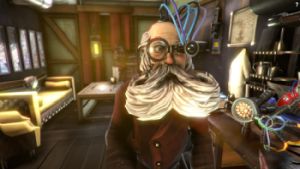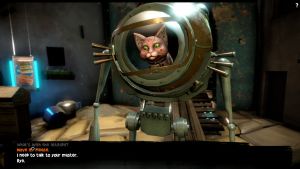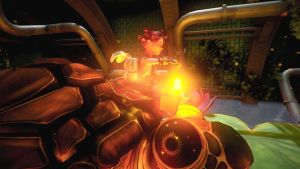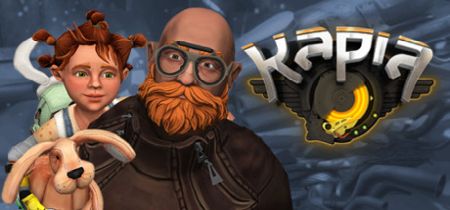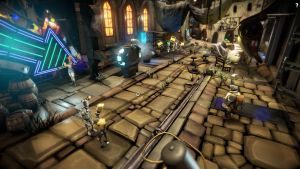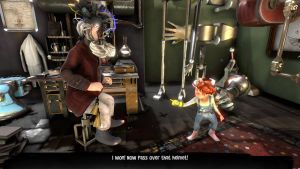|
By flotsam
KAPIA
2FOR2
From a husband and wife team based in Montenegro,
KAPIA tells the story of a collapsed World Union, beset by divided
coalitions geographically, politically and societally, and an
intelligent infection forcing cities into lockdown. The soul of the land
has died, and the world needs saving. Up steps Stefan and his young
granddaughter Reny.
It’s a fantastical world, described by its makers as
a reimagined living museum. Those elements are evident throughout, a 3D
pastiche of “old” and “new.” There is a funkiness about the animation
style, one that suits the world it establishes and the denizens that
inhabit it. It is a world full of colour and movement and detail, plus a
wonderment or two.
You get to play both Reny and Stefan, but not by
choosing between them. Each has a converging narrative, one far more
mundane when it starts than the other, but arriving at a common point.
The game flicks back and forth between them, and they contrast nicely
with each other as well as being reflective of the characters
themselves.
The game is point and click (at least when played
with a mouse) and plays in the third person with a free-wheeling POV, by
which I mean that the “camera” isn’t fixed in any way, moving around
almost as much as you do as you explore. It might be behind you, then
swing around to watch you as you walk the street, and then swoop up and
overhead to observe from on-high. It might stay down low and watch as
you walk the alleyway between two buildings, or get right in tight as
you explore a bedroom or other confined space. I thought it accentuated
the 3D environment, and enhanced the living-world feel of things.
It did though at times make exploring a bit fiddly.
You can’t force the camera to move, other than by moving your character,
and nor can you tell it where you would like it to be. There were times
when the camera was in tight, so where I could click to move was
limited, and I needed to make several little moves before the camera
pulled back out and gave me more room. It can also affect what you can
see, in that you can’t for instance turn around to quickly take in a
room upon entering, but will have to move about until you are satisfied
the camera has “shown” you the room’s entirety. I also missed one or two
things because I hadn’t moved to a particular point; doing so then
pulled the camera in showing me the space immediately in front of me and
revealing what hadn’t been apparent before.
Most games though require you to explore carefully,
and if you don’t look where you should then you will miss things. So
despite my occasional grimace of agitation and wishing for a button that
would shift the camera, overall I quite enjoyed what this element
contributed to the experience.
The story is quite an elaborate one, and traverses
some futuristic as well as some more familiar themes. Its telling is
spread out across the five or so hours it took me, and never felt
forced. While Stefan is the main character for its unravelling, Reny
does her bit as well, and helps build the world itself.
Logic and diversity was the key to the puzzling
according to the makers, and by and large that approach was met. Many
involve finding and using the right items, either in the game world or
with other items. Some can be combined in the inventory bar that appears
top of screen in response to the mouse, others must be looked at in
close up, and then have another item applied in some way. There are also
conversation puzzles, which are fairly forgiving (choose a wrong answer
and you just get to try again), and what the makers describe as “a whole
bunch of logic mini-games.” Some of these are really out and out
puzzles, but a couple need to be completed in a certain time which
introduces a gaming element. There is indeed a logic to them, you just
have to perform it in the time allowed. Several tries are part and
parcel of determining and then applying that logic.
One was not logical. You play a boxing game with
little toy robots early on, a game you have to win two out of three
times (as far as I could tell no amount of losing lets you move on). You
may have a different view, blocking punches and striking back
strategically, but while it wasn’t too difficult (and provided further
variety), it wasn’t a whole lot more than a rapid click-fest.
There are a handful of other sorts of puzzles
(controlling Robot Robbi with the helmet is an example), and some have
several parts to a successful solution. I enjoyed the puzzling palette,
and while it isn’t a hard game you can choose to be assisted by a hint
system which you can turn on and off at will. It has a timed element as
well (you have to wait a certain amount of time before a hint becomes
available), indicated by the little stop watch/es top right of screen.
They might be an answer or they might be a prod or an insight into what
to do next. I can’t speak for all of them, but when I used them they
were helpful.
I should mention that if you see an image with eg.
Reny walking on a barrel, don’t think that you have to have a degree of
dexterity to keep her there. You will move her and the barrel around but
she doesn’t fall off. Similarly, she won’t fall off the roof beams you
are walking her about; just click where you want her to go and she will
walk there. Maybe I missed something, but this isn’t a game that wants
you to balance precariously.
Your endeavours are accompanied by a varied and not
overused soundtrack, and ambient sound abounds. Voice acting is suitably
eclectic, and while some leave a little to be desired, nothing grated.
Importantly, the leads were both strong.
Clicking on a character will generate look and talk
icons, and clicking hotspots will produce similar results. You can
choose how the inventory operates in the options (drag and drop or click
and click again), and you can tweak a range of settings, including
whether to have subtitles or not. The TAB key highlights hotspots, and
load screens are accompanied by a rather nifty set of drawings by
different children, the colour bleeding in as the screen loads. Each
drawing is attributed, and full details are in the credits.
KAPIA autosaves exclusively, and you can just resume
where you left off. It saves regularly and works fine, but while you can
choose to replay the “level” you are on, you can’t reload any earlier
save, and starting a new game deletes all your progress. You don’t
really need more than the single autosave point, unless like me you
enjoy going back to re-play certain sequences or explore how some
particular aspect works. Regardless, I doubt it will detract from your
overall enjoyment.
Which should be considerable, based on my own.
I played on:
OS: Windows 10, 64 Bit
Processor: Intel i7-9700K 3.7GHz
RAM: Corsair Dominator Platinum RGB DDR4 32GB
Video card: AMD Radeon RX 580 8192MB
Grade B
GameBoomers Review Guidelines
January 2022
design copyright© 2022
GameBoomers
Group
 GB
Reviews Index GB
Reviews Index |
